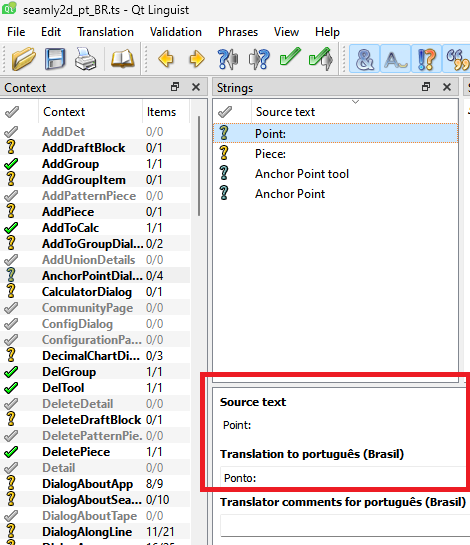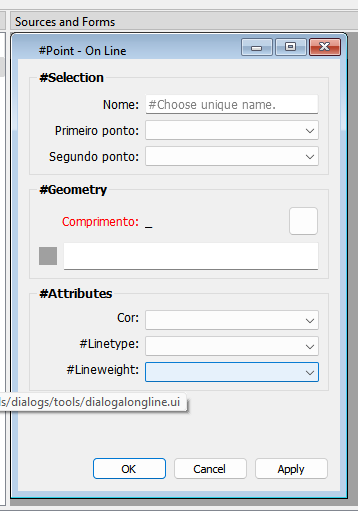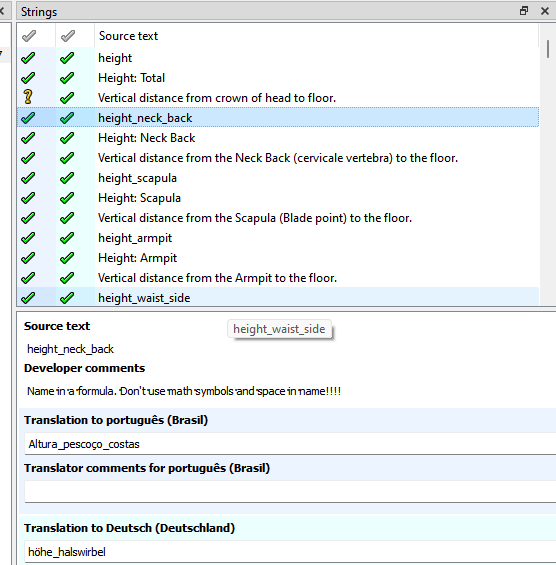Hi, everyone!
I’ve recently started using Seamly and I’d like to help with the translations to portuguese, but I’m not a developer ![]()
Is there any way I could help without actually getting my hands into the source code?
Thank you! ![]()
Hi, everyone!
I’ve recently started using Seamly and I’d like to help with the translations to portuguese, but I’m not a developer ![]()
Is there any way I could help without actually getting my hands into the source code?
Thank you! ![]()
Hello and welcome to the forum, @acosturadodia.
I’ve been looking to find where there are specific instructions on how to do this but I’m afraid I got lost myself, so I can’t expect you to find how to do this, but the most recent conversation is here.
Perhaps @Douglas can point us in the right direction or write a small tutorial on how to do this?
At minimum you have to at least have a current copy of the Portuguese translation (TS) files. You could edit it with any text editor, but I highly suggest that one use the Qt Linguist application to edit ts files. It will keep you from mangling the files, plus it’s just way easier to use.
You can download your OS ver of Linguist from here:
And here are the measuement and seamly2d ts files. I had to rename them with “.val” at the end to post here. Rename without the .val, and you can load them into Linguist to edit the translations. To make it easier you can just repost (or send me) the edited ts files back and I can add them to the repo.
measurements_pt_BR.ts.val (228.5 KB) seamly2d_pt_BR.ts.val (595.5 KB)
When you load a ts file in Linguist it will look like this… with the Context box to the left - context meaning what part of the app the texts are located in. There is then the Strings box to the right which are the text strings that are translated. For the most part the ones with yellow ? marks in the Context box or the grey ? marks in the Strings box are the ones that don’t have a translation. Below the Strings box is the Source text and Translation (Red box in screencap). This is where you enter the translation. Also you’ll want to keep an eye the Warnings box, as it will alert you to something that may be wrong with the translation. Otherwise it’s just a matter of elimininating as many grey check and ? marks as possible. A green checkmark means the translaion has been verified to be correct. A yellow ? mark will have a translation, but it may or may not be correct. For example… I could use Google to fill in Portugueses translations, but since I don’t speak Portuguese I have no idea if the translation is correct or correct for the context it’s used in. If someone is fluent in both languages, then one can use the Green checkmark in the toolbar to Mark item as done… or verify it’s OK. Ideally we would want every Context item to be a green checkmark - meaning that language is 100% translated.

OR… by converting the ts file to an xlsx file and uploading it to Google Translate, then downloading the tanslated xlsx file, and converting back to ts.
Thank you very much for this, @Douglas I’ve downloaded everything and it’s very clear and easy to do the translations using the Qt Linguist. ![]()
If not tedious. Yeah… other than watching out for some warnings- usually puncuation related, and words that may be ambiguous - it’s rather straightforward.
I’m rather perplexed though why the Context box uses a yellow ? mark to indicate unfinished words for a Context, while the the Strings box uses a grey ? mark… unless maybe if all the words in the Context need translating then it’s grey? I probably should read the docs. Lol
I think for the heck of it I’m going to try and convert a ts file and use Google Translate… if that works we can have all the languages translated overnight, and even add new ones no problem. It still would be a good thing though to have a person that speaks a given language to check and mark it as OK in Linguist.
I was thinking the same thing but using DeepL which doesn’t support a lot of languages but I find it more accurate. If you send me a few of the files, I can help on Sunday and evening… Loadshedding allowing.
If you want I can zip all the most current trans files and PM them to you?
Thank you. I’ll work through them.
Hi! Thank you so much! I’ll start next week and let you know when it’s finished.
Any updates on this topic? I would also like to contribute to rounding up the translation to Brazilian Portuguese.
Hello and welcome to the Seamly forum, @Stepan & @bellaa
You don’t need to be a developer to work on the translations. You only need to download QT Linguist as mention in the topic above. All of the directions are there.
That’s great news! I will start working on it right away and post the results here. I’ll update the status of the work at the end of the week.
Hi Stepan…
If you’re not familar with using git and pushing (translation) changes to Github and making PR’s… the easiest thing to do is once you have translated - preferably in Linguist - the ts file (which would be the seamly2d_en_GB.ts for Brazil) is to message me the file. I can then check and make sure the file passes all the tests and get it merged into the repo.
I also suggest to read the translation topic I posted in awhile back where I laid out a few do’s and don’t with the translations. If not done correctly a bad translation file will cause the build to fail. Which is why I also suggest to anyone to use Linguist as it will help prevent many of the errors hand editing can cause. Since we’ve added the location tags Linguist will also give you a visual context of dialogs and code of where the translation is being used.

Hello Douglas. I am doing a manual translation of the measurements using Qt Linguist. I would say I am a quarter of the way on the “measurements”. Hope to be done by next week. For the main file “seamly2d.ts” it would be a good idea to convert to xlsx and use google or gpt to translate and then go through the terms just to verify if they are adequate. I tried to convert .ts to .xlsx to make things faster but I had a hard time trying to make the qt converter on github work - I am not a developer. If you know an easier way - or if you can share the converted file with me - let me know.
You can try, but there’s many things that are specific to Seamly… for ex: there are developer comments you can see when editing in Linguist - like don’t translate this

or punctuation doesn’t match.
![]()
If you try to just translate the whole file, it’s probably going to mess things up. In some cases you may have to use a shorter translation than what might normally be the acceptable translation to fit it in a dialog. That’s why I pointed out the dialog context in Linguist, where you can see what it looks like translated.
BTW everyone… I just discovered you can actually translate multiple languages simultaneously in Linguist. ![]()
